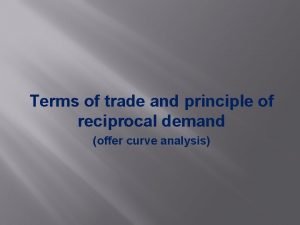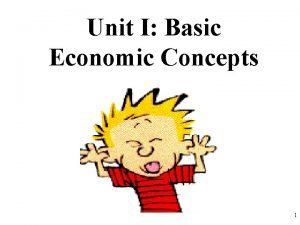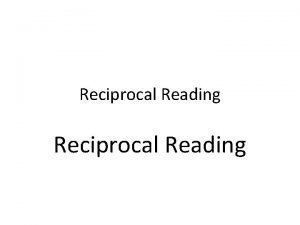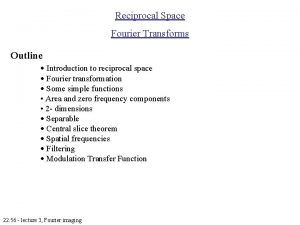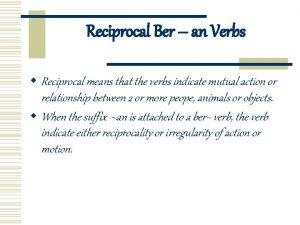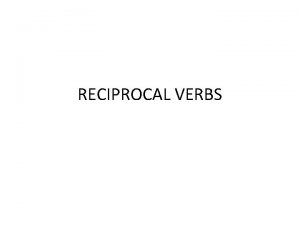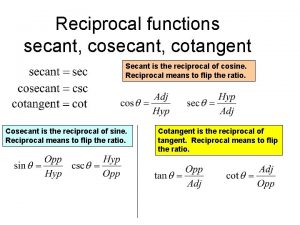Terms of trade and principle of reciprocal demand
















- Slides: 16

Terms of trade and principle of reciprocal demand (offer curve analysis)

q 1. Meaning of terms of trade: Terms of trade refer to the physical exchange ratio at which goods are exchange for one another between the countries. Index of export prices(PX) x 1 oo Terms of trade(T)= Index of import prices(Pm) (Here, T=Terms of trade; PX= Index of export prices; Pm=Index of import prices. ) This is also called the index of trade. Terms of trade are used to measure the gain or loss from international trade. Terms of trade can be favourable or unfavourable to a nation. 1) Favourable Terms of trade: Terms of the trade become favourable for a country if this index increase. Export prices increase by 15% and import prices increase by 5%, then the index of terms of trade increase from 100 to 109. Terms of trade (TOT) = 115/105 x 100= 109(approx. ) 2) Unfavourable Terms of trade: Terms of trade becomes unfavourable when percentage change in export prices is less than the percentage change in import prices. Then the terms of trade index should be: Terms of trade (TOT)=105/110 x 100=95(approx. )

Formula:

2. Types of Terms of Trade : Main types of terms of trade, according to Jacob Viner and Meier are s follows: 1) Net Barter or commodity Terms of trade 2) Gross Barter Terms of trade 3) Income Terms of trade 4) Single Factoral Terms of trade 5) Double Factoral terms of trade 6) Real costs terms of trade 7) Utility terms of trade

� (1) Net Barter or Commodity Terms of Trade : Commodity terms of trade are expressed in a formula as under: TC=PX/Pm (here, TC= commodity terms of trade; PX= Index of export prices; Pm= Index of import prices. ) Commodity terms of trade in different time period can be measured by the following formula: Px 1/Pm 1 : Pxo/Pmo (here, Px 1= index of export prices in the current year, Pm 1=Index of import price in the current year; Pxo=Index of export price in the base; Pmo=Index of import prices in the base year. ) Criticism: The principle of commodity terms of trade has been criticised on the following grounds: i. The principle of commodity terms of trade is based on export and import prices indices. It does not take into consideration the changes in composition of the foreign trade and quality of the goods. ii. The concept examines short-terms changes only. It throws no light on long -term changes.

� (2) Gross Barter terms of trade : Gross commodity terms of trade are expressed in a formula as under: TQ= Qm/Qx (Here, TQ= Gross barter terms of trade; Qm=Quality of imports; QX= Quantity of exports. ) Gross barter or commodity terms of trade in different time periods can be measured as follows: Qm 1/QX 1 : Qmo/Qxo (here, Qm 1= Index of quantity imported in the current year; Qx 1=Index of quantity exported in the current year; Qmo=Index of quantity imported in the base year; Qxo= Index of quantity exported in the base year. ) Criticism: Gross commodity terms of trade are criticised as under: i. iii. According to Taussig, gross commodity terms of trade include unilateral transactions, like donation, gifts, etc. , in balance of payments, but it is not proper because it does not represent the natural flow of trade. Gross commodity terms of trade do not provide any clue of payment of capital and its effect. Like net commodity terms of trade, gross commodity terms of trade also do not attach any importance to changes in the quality of goods.

� (3) Income terms of trade : The income terms of trade is the ratio of index of the prices of exports and index of prices of imports. Ty= Tc. Qx=Px. Qx/Pm (Tc=Px/Pm) (here, Ty=Income terms of trade; Tc= Commodity terms of trade; Px= Index of prices of exports; Qx=index of quantity exported ; Pm=Index of prices imports. ) Income terms of trade are also called capacity to import. It is so because, in the long-run, the value of total export of a country is equal to the value of its total imports. Px. Qx= Pm. Qm (Px. Qx/Pm =Qm) [Qm= quantity of imports] Criticism : main criticism of income terms of trade is as follows; Concept of income terms of trade does not throw any light on the profits and losses of international trade. Concept of income terms of trade is a narrow concept. Index of income terms of trade relates to the capacity of imports as being dependent only on exports. i. ii. � (4) Single factoral terms of trade: Factoral terms of trade depend upon the productive efficiency of the factors of production. The single Factoral terms of trade, commodity terms of trade are multiplied by the index of export productivity. Ts= Tc x Fx= Px/Pm x Fx ( Tc= Px/Pm)

Criticism : According to critics, the greatest shortcoming of single factoral terms of trade is that it does not take into consideration potential domestic cost of production of input industries of importing country. � (5) Two Factoral Terms of trade : Double factoral terms of trade takes into account the productivity of the factors of production in the country’s exports as well as the productivity of the foreign factors of production used in country’s imports. Td= Tc x Fx/Fm = Px/Pm x Fx/Fm ( Td= Px/Pm) (here, Td=Double factoral terms of trade; Tc= commodity terms of trade; Px= Index of prices of exports; Fx=Index of productivity of export goods industries; Pm=Index of prices of imports; Fm= Index of productivity of import goods industries. ) Criticism: Main criticism of the concept of double factoral terms are as under: i. ii. It is very difficult to estimate the index of double factoral terms of trade of a country, because to do so it is necessary to measure the productivity of import goods produced in the country. It is not possible to measure gains of international trade by this concept, because no importance is given to the utility of the goods exported and imported.

� (6)Real Cost terms of trade : Import and export goods are compared according to their utility. Real cost of both import and export is worked out. Real cost terms of trade is calculated by multiplying the single factoral terms of trade with the index of the amount of disutility per unit of productive resource used in producing exports. TR= Ts x Rx = PX/Pm x Fxx Rx (here, TR= Real cost terms of trade; Ts= Single factoral terms of trade; Px=Index of export prices; Pm=Index of import prices; Fx=Index of productivity of export goods industries; Rx= sacrifice of utility inherent in export. ) Criticism: Main defect of real cost terms of trade is that it is concerned only with the quantity of foreign goods obtained with the real costs inherent in exports. � (7) Utility terms of trade : Utility terms of trade is the index of relative utility of import and domestic commodities foregone to produce exports. Tu= TR x U = Px/Pm x Fx x Rx x U (here, Tu=Utility terms of trade; TR=Real cost terms of trade; PX=Index of export prices; Pm=Index of import prices; Fx=Export productivity; Rx= Utility foregone to exports. ) Criticism : It is an unrealistic concept. Utility and disutility cannot be measured precisely. Both concepts are subjective. This concept has no practical significance

Factor influencing Terms of trade : 1. Reciprocal Demand: (i) Elasticity of Demand: The following effect on terms of trade: (a) Elasticity of Demand of Export Goods: The demand of exports of a country is less elastic then terms of trade will be in its favour. (b) Elasticity of demand of Import Goods: Terms of trade will be favourable to a country whose demand for imports is more elastic. On the other hand, if the demand for imports is less elastic, terms of trade will be unfavourable. (ii) Elasticity of supply: elasticity of supply has the following effect on terms of trade: (a) The supply of export is less elastic terms of trade will be unfavourable and if more elastic the same will be favourable. (b) Supply of imports is less elastic, terms of trade will be favourable and if supply of import is more elastic, terms of trade will be unfavourable. 2. Size of Demand: With the increase in demand for the exports of a country, prices of export will increase as against the prices of imports and hence, terms of trade become favourable. If demand for imports increase, their prices will also increase as against the prices of export and so the term of trade become unfavourable.

(3) Availability of Substitutes : If the substitutes of the goods import become available in the same country, then terms of trade will be favourable to it. If the substitutes of the goods exported become available in the foreign countries then terms of trade will be unfavourable to the exporting country. (4) Tastes and preferences of the People : The people of a country have a craze for imported goods and they give preference to their consumption, then terms of trade will be unfavourable to the country. People have little preference for imported goods, terms of trade will become favourable to the country. (5) Size of population : Intensity of demand for imported goods is relatively more for a country having large population. Terms of trade will be favourable for a country having small population. (6) Change in factor endowments and technology : With increase in the availability of factor endowments and use of improved technology, export will increase more than imports. (7) Effects of Tariff : Other things being equal with increase in custom duties, import falls. Consequently, terms of trade will become favourable (8) Devaluation : as a result of devaluation exchange rate of the currency of the country depreciates. It may lead to favourable or unfavourable terms of

Principal of Reciprocal Demand(Derivation of offer curve): - The point at which terms of trade are determine by the reciprocal demand of two countries, i. e. , demand of country A for the goods of country B and demand of country B for the goods of country A. Assumptions: Main assumptions of the reciprocal demand theory are as under: Ø This theory applies to countries trading two goods (2 x 2) Ø There is full employment in the countries. Ø Both countries are almost of equal importance. Ø There is perfect competition. Ø Foreign trade is based on free trade. Ø Factors are perfectly mobile. Ø Theory of comparative costs holds goods.

Main characteristics of theory are as under: Explanation: Ø Terms of trade imply barter terms of trade. Ø Gain to every country from trade is determined by terms of trade. Ø The limits within ehich terms of trade are settled are determined by the ratios of domestic costs in the country concerned.



 Theory of reciprocal demand
Theory of reciprocal demand Bragg's law in reciprocal lattice formula
Bragg's law in reciprocal lattice formula Module 5 supply and demand introduction and demand
Module 5 supply and demand introduction and demand Like terms and unlike terms in polynomials
Like terms and unlike terms in polynomials How to combine like terms
How to combine like terms Trade diversion and trade creation
Trade diversion and trade creation Umich
Umich Which is the most enduring free trade area in the world?
Which is the most enduring free trade area in the world? Trade diversion and trade creation
Trade diversion and trade creation Trampliner
Trampliner Deficient demand and excess demand
Deficient demand and excess demand Dependent demand inventory means
Dependent demand inventory means Kahulugan ng demand schedule
Kahulugan ng demand schedule Demand estimation and forecasting in managerial economics
Demand estimation and forecasting in managerial economics Paradox of value
Paradox of value Inventory models for independent demand
Inventory models for independent demand How to determine terms of trade
How to determine terms of trade
